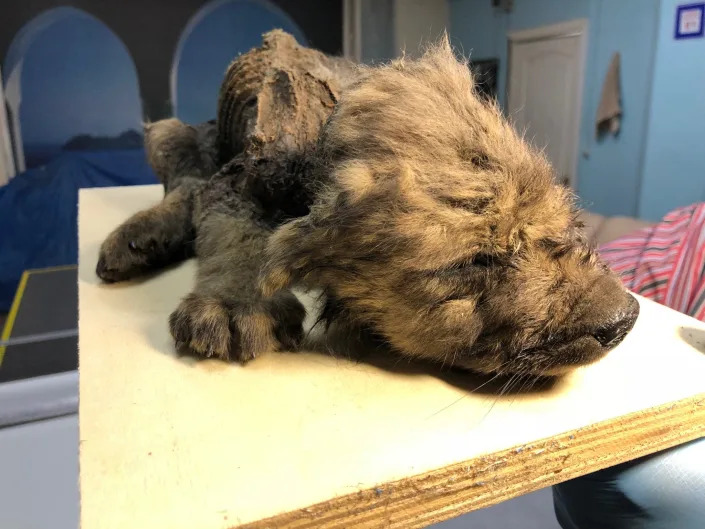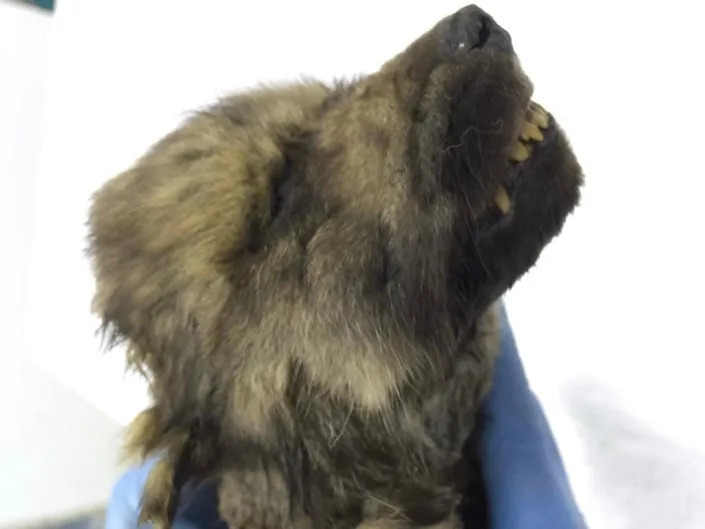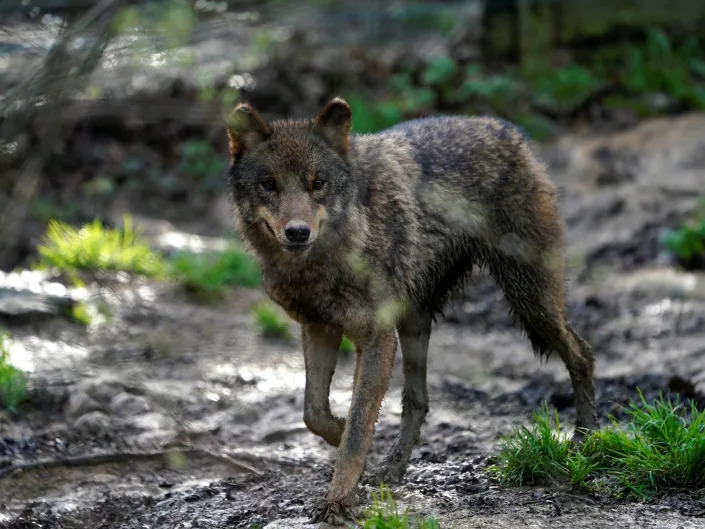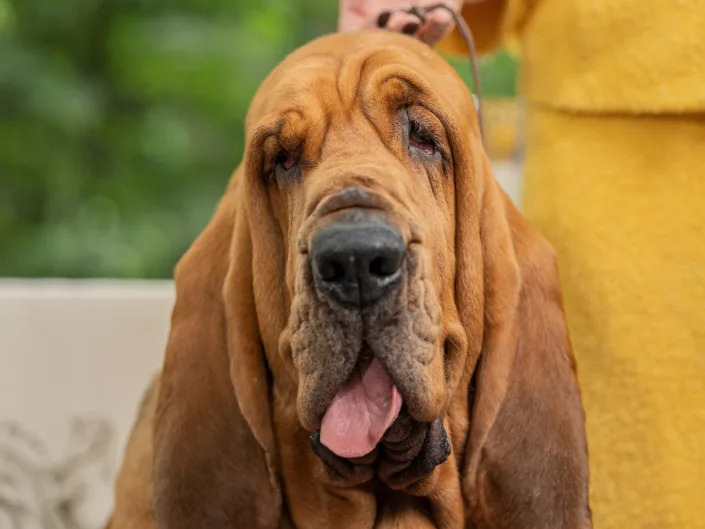A massive new wolf family tree dating back 100,000 years could help researchers understand where dogs were first domesticated
Sarah Kuta
SMITHSONIAN
Daily Correspondent
:focal(960x571:961x572)/https://tf-cmsv2-smithsonianmag-media.s3.amazonaws.com/filer_public/79/a1/79a14d0e-b44f-42be-aa1a-50a47b24f96e/wolf-2984865_1920.jpg)
Scientists—and plenty of doting dog owners—have long wondered when and where wolves began their evolution to become humanity’s best friend.
And though they haven’t fully solved it, researchers have now added a big, new piece to the dog domestication puzzle. Today’s modern dogs may have descended from two separate populations of ancient wolves: one in eastern Asia and another in the Middle East, according to a new paper published this week in Nature.
While two distinct domestication events are possible, another explanation is that dogs were domesticated in one location, then later bred with wolves elsewhere, intermixing their DNA.
“We can’t tell [the two different] scenarios apart,” says Anders Bergström, an evolutionary genomicist at the Francis Crick Institute and an author of the study, to the New York Times' Emily Anthes. “But we can say that there were at least two source populations of wolves.”
/https://tf-cmsv2-smithsonianmag-media.s3.amazonaws.com/filer_public/45/5d/455dbb0e-dd89-4f24-b91c-5985b3930a03/daisy_at_the_beach.png)
Researchers generally agree that modern-day dogs evolved from grey wolves (Canis lupus) at least 15,000 years ago, during the last Ice Age. But nearly everything else about the domestication of dogs is a mystery, including when, where and with what group of humans wolves began to evolve into dogs. Past research has concluded that dogs may have been first domesticated in Asia, Europe, the Middle East or, possibly, in multiple locations.
This new paper doesn’t pinpoint the exact location of dog domestication, but it does offer some important insights into wolf genetics. More than 80 researchers from 16 countries joined together for this research, which involved sequencing the genomes of 66 ancient wolves and analyzing six additional previously sequenced genomes from archival remains. The wolves analyzed in this study lived in Europe, Siberia and North America over the last 100,000 years.
With the sequenced genomes in hand, the researchers used computer software to compare and contrast the 72 animals with the genome of today’s dogs, creating an ancient genetic family tree.
As a whole, the research creates a much more “detailed picture of wolf ancestry, including around the time of dog origins,” Bergström says in a statement, which will undoubtedly help scientists get one step closer to figuring out exactly when and where dogs were domesticated.
“Having this many ancient wolf genomes is a huge advance in the field,” Adam Boyko, a canine geneticist at Cornell University who was not involved in the study, tells the New York Times. “I’m sure other researchers are going to love to get their hands on it and explore some of their own pet theories.”
Despite the diversity of wolf DNA, the researchers didn’t find a singular ancient wolf that is directly related to all modern dogs. But they did learn that dogs are more similar genetically to ancient wolves in Asia than wolves in Europe, which builds on previous research that suggests dogs likely originated somewhere in Asia.
The samples “help narrow down the place of origin,” says Yohey Terai, an evolutionary biologist at Japan’s Graduate University for Advanced Studies who was not involved in this paper, to Science’s Michael Price.
/https://tf-cmsv2-smithsonianmag-media.s3.amazonaws.com/filer_public/f8/20/f820d699-de6c-45d9-96e3-3a8773e372ca/low-res_credt_sergey_fedorovjpeg.png)
To more directly link dogs with an ancient wolf population, researchers simply need more specimens from all around the world, particularly from samples from the southern hemisphere. But that’s challenging because DNA is best preserved in colder climates, hence the more abundant samples from the northern hemisphere used in this study.
“There are still big parts of the map where we don’t have many samples,” Bergström tells the New Scientist’s Jason Arunn Murugesu.
The scientists were also surprised to learn how genetically connected the various wolf populations remained over tens of thousands of years around the world, which suggests the canines likely traveled and mated periodically. That may have allowed wolves to survive the end of the Ice Age, while many other mammals went extinct, per the New York Times.
In addition, the study answered a question that had been perplexing researchers since archaeologists uncovered an 18,000-year-old pup in Siberia in 2019: Was it a wolf or a dog? After studying its genetics, the scientists determined it was a wolf.
Sarah Kuta is a writer and editor based in Longmont, Colorado. She covers history, science, travel, food and beverage, sustainability, economics and other topics.
The first dogs evolved from wolves in Asia — and maybe the Middle East — a study of ice age DNA suggests

Ice age Siberian wolf DNA is similar to early and modern dog DNA, a study of 100,000 years of wolves found.
The finding adds to evidence that dogs were domesticated in Central Asia during the last ice age.
The study also found genetic links between a subgroup of dogs and ancient wolves in the Middle East.
Dogs are one of humankind's greatest historical mysteries. Nobody is quite sure where they came from, but a new analysis of ancient wolf DNA points to somewhere in Asia.
A cohort of geneticists, led by researchers at the Francis Crick Institute, analyzed the genomes of 72 ancient wolves that were excavated across Europe, Siberia, and North America. The DNA spanned 100,000 years and 30,000 generations of wolves.
Then the researchers compared the wolf DNA to genomes of modern and ancient dogs. The dogs were most similar to gray wolves in Siberia about 13,000 to 23,000 years ago — during the last ice age.

"That's consistent with a wolf population from Central Asia leading to the origin of dogs," Adam Boyko, a canine geneticist at Cornell University, who was not involved in the study, told Insider. His own research analyzing the genomes of village dogs across the world — the semi-feral kind that aren't bred for particular traits — has pointed to the same region as the origin of dog domestication.
"Now we've got this mirror image dog-wolf analysis, both pointing to Central Asia as an origin," he said. Still, he cautioned, "I don't think that the final story has been written yet."
Ancient dogs in the Middle East, Africa, and Southern Europe also show ancestry from wolves in the Middle East, in addition to their Central Asian roots. That could indicate either a second instance of domestication in the Middle East, or dogs there interbreeding with wild wolves.
The researchers published their study in the journal Nature on Wednesday.
The new genetic history of ancient wolves shows evolution in real time

With their new library of ancient DNA, the researchers could see wolves changing over the ages.
"This is the first time scientists have directly tracked natural selection in a large animal over a time-scale of 100,000 years, seeing evolution play out in real time rather than trying to reconstruct it from DNA today," Pontus Skoglund, study author and leader of the Francis Crick Institute's ancient genomics lab, said in a press release.
They saw one gene variant, which affects the development of skull and jaw bones, go from an anomaly to showing up in every wolf's DNA over a period of 10,000 years. Scientists think that variant is present in all wolves and dogs today.
The work is similar to the ancient DNA analysis that has revealed how genetic mutations, like the one that allowed humans to digest lactose, emerged in humans and spread across the globe.

Like Homo sapiens and Neanderthals, dogs and wolves have mingled and interbred as long as the two species have existed. That's made it difficult for scientists to trace genetic traits passing from one species to the other, and even more difficult to pinpoint when and where dogs were first domesticated.
No modern-day wolf population is more genetically similar to dogs' ancestors than any other modern-day wolf population. Overall, ancient wolves are more similar to other ancient wolves on the other side of the continent than they are to modern-day wolves living in the same areas. Ancient wolves traveled great distances and bred, sharing their genes across those distances.

"This connectivity is perhaps a reason why wolves managed to survive the ice age, while many other large carnivores vanished," Skoglund said.
That connectivity also makes an especially tangled ball of genetic yarn for researchers to unravel as they try to link dog domestication to a single wolf population. This study adds to the evidence for a single instance of domestication somewhere in Asia.
The Francis Crick Institute researchers are now turning their attention to genomes from other locations that weren't included in this study, in hopes of narrowing down where exactly domestication happened.

Boyko has still more questions about the domestication of Asian gray wolves, including how humans in the area at that time fit into the picture.
"After that happened is when we had the domestication of wheat, and the domestication of cats, and the domestication of cattle and pigs and all of the other species that go with being a modern human," Boyko told Insider.
"But dogs were the first. To what extent do we need domestic dogs before we had agriculture? Or is it just by chance that it happened in that order? It's kind of interesting to think about, staring into your dog's eyes and wondering what actually brought the wolf out of the den and into the campsite."
No comments:
Post a Comment